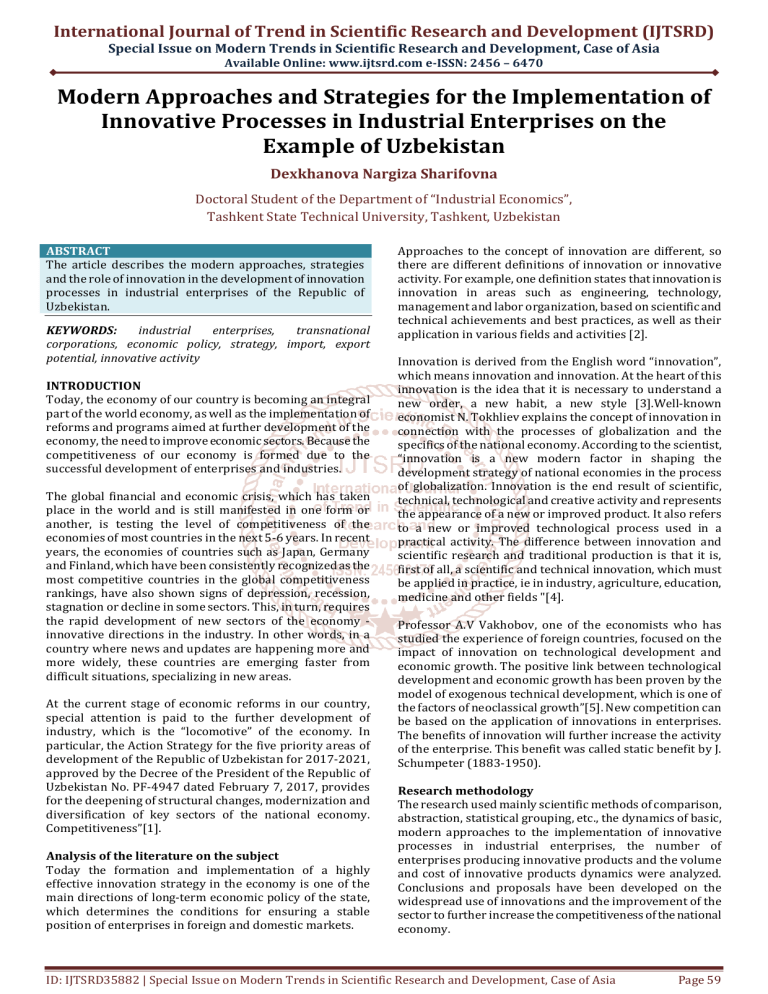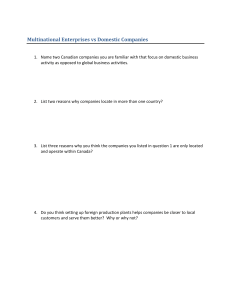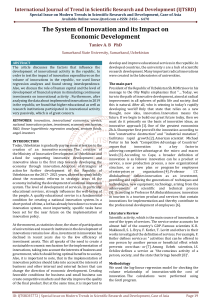
International Journal of Trend in Scientific Research and Development (IJTSRD)
Special Issue on Modern Trends in Scientific Research and Development, Case of Asia
Available Online: www.ijtsrd.com e-ISSN: 2456 – 6470
Modern Approaches and Strategies for the Implementation of
Innovative Processes in Industrial Enterprises on the
Example of Uzbekistan
Dexkhanova Nargiza Sharifovna
Doctoral Student of the Department of “Industrial Economics”,
Tashkent State Technical University, Tashkent, Uzbekistan
ABSTRACT
The article describes the modern approaches, strategies
and the role of innovation in the development of innovation
processes in industrial enterprises of the Republic of
Uzbekistan.
KEYWORDS:
industrial
enterprises,
transnational
corporations, economic policy, strategy, import, export
potential, innovative activity
INTRODUCTION
Today, the economy of our country is becoming an integral
part of the world economy, as well as the implementation of
reforms and programs aimed at further development of the
economy, the need to improve economic sectors. Because the
competitiveness of our economy is formed due to the
successful development of enterprises and industries.
The global financial and economic crisis, which has taken
place in the world and is still manifested in one form or
another, is testing the level of competitiveness of the
economies of most countries in the next 5-6 years. In recent
years, the economies of countries such as Japan, Germany
and Finland, which have been consistently recognized as the
most competitive countries in the global competitiveness
rankings, have also shown signs of depression, recession,
stagnation or decline in some sectors. This, in turn, requires
the rapid development of new sectors of the economy innovative directions in the industry. In other words, in a
country where news and updates are happening more and
more widely, these countries are emerging faster from
difficult situations, specializing in new areas.
At the current stage of economic reforms in our country,
special attention is paid to the further development of
industry, which is the “locomotive” of the economy. In
particular, the Action Strategy for the five priority areas of
development of the Republic of Uzbekistan for 2017-2021,
approved by the Decree of the President of the Republic of
Uzbekistan No. PF-4947 dated February 7, 2017, provides
for the deepening of structural changes, modernization and
diversification of key sectors of the national economy.
Competitiveness”[1].
Analysis of the literature on the subject
Today the formation and implementation of a highly
effective innovation strategy in the economy is one of the
main directions of long-term economic policy of the state,
which determines the conditions for ensuring a stable
position of enterprises in foreign and domestic markets.
Approaches to the concept of innovation are different, so
there are different definitions of innovation or innovative
activity. For example, one definition states that innovation is
innovation in areas such as engineering, technology,
management and labor organization, based on scientific and
technical achievements and best practices, as well as their
application in various fields and activities [2].
Innovation is derived from the English word “innovation”,
which means innovation and innovation. At the heart of this
innovation is the idea that it is necessary to understand a
new order, a new habit, a new style [3].Well-known
economist N. Tokhliev explains the concept of innovation in
connection with the processes of globalization and the
specifics of the national economy. According to the scientist,
“innovation is a new modern factor in shaping the
development strategy of national economies in the process
of globalization. Innovation is the end result of scientific,
technical, technological and creative activity and represents
the appearance of a new or improved product. It also refers
to a new or improved technological process used in a
practical activity. The difference between innovation and
scientific research and traditional production is that it is,
first of all, a scientific and technical innovation, which must
be applied in practice, ie in industry, agriculture, education,
medicine and other fields "[4].
Professor A.V Vakhobov, one of the economists who has
studied the experience of foreign countries, focused on the
impact of innovation on technological development and
economic growth. The positive link between technological
development and economic growth has been proven by the
model of exogenous technical development, which is one of
the factors of neoclassical growth”[5]. New competition can
be based on the application of innovations in enterprises.
The benefits of innovation will further increase the activity
of the enterprise. This benefit was called static benefit by J.
Schumpeter (1883-1950).
Research methodology
The research used mainly scientific methods of comparison,
abstraction, statistical grouping, etc., the dynamics of basic,
modern approaches to the implementation of innovative
processes in industrial enterprises, the number of
enterprises producing innovative products and the volume
and cost of innovative products dynamics were analyzed.
Conclusions and proposals have been developed on the
widespread use of innovations and the improvement of the
sector to further increase the competitiveness of the national
economy.
ID: IJTSRD35882 | Special Issue on Modern Trends in Scientific Research and Development, Case of Asia
Page 59
International Journal of Trend in Scientific Research and Development (IJTSRD) @ www.ijtsrd.com eISSN: 2456-6470
Analysis and results
In the current context of deepening the process of
liberalization of the economy, one of the urgent tasks is to
increase the innovative activity of industrial enterprises,
identify factors to increase its potential, develop the main
directions of strengthening the organizational and legal
framework. The “Strategy for Innovative Development of the
Republic of Uzbekistan for 2019-2021 was adopted. A “road
map” for the implementation of the strategy of innovative
development of the Republic of Uzbekistan in 2019-2021 has
been developed. One of the main directions of strategy is the
creation of techno parks, free economic zones, free industrial
zones and research and production clusters for the
development and introduction of advanced technologies,
production of domestic scientific products with foreign
partners and its sale in foreign markets strengthening state
support for the formation of joint organizations is one of the
main directions of the Strategy.
As a result of economic reforms in Uzbekistan, real owners of
industrial enterprises are emerging, but the study of
innovation processes in enterprises or the widespread use of
research is one of the most pressing issues. In particular, the
Decree of the President of the Republic of Uzbekistan dated
January 10, 2019 “On measures to radically improve the
system of implementation of state policy in the field of
economic development” is a very important document in
terms of accelerating industrial development. By this Decree,
the Ministry of Economy of the Republic of Uzbekistan was
reorganized into the Ministry of Economy and Industry of
the Republic of Uzbekistan. This ministry has been
designated as the authorized state body for the development
and implementation of state policy in the field of socioeconomic and industrial development of the country, as well
as the strategy of investment policy of the Republic of
Uzbekistan [7].
One of the most important strategic issues facing the Uzbek
economy is to increase the capacity of enterprises to apply
innovations. This issue prevents the emergence of
disruptions in the nodal directions of the formation of a lowindustrial technological method of production and the way
out of the technological crisis. Taking into account the need
to develop the use of innovations in strengthening the
competitiveness of all industries and export potential in the
country, the formation of modern organizational, economic
and management mechanisms for the implementation of this
process plays a very important role in addressing these
issues. In particular, the creation of investment and
innovation departments in industrial enterprises, as well as
the creation of all conditions for the development of its
activities will bring great economic benefits.
In the world experience, there are three ways of innovative
development strategy:
Raw-based and often smaller rich countries
applied strategy (UAE);
Simulation-flexible or chasing strategy, including from
abroad
more emphasis is placed on the acquisition of patents
and licenses (bright experience Japan);
Innovative development of countries with sufficient
financial resources to spend large sums on education,
science and technology (USA, Germany, UK)
Researchers have identified different stages in the
development of an organizaion’s innovative development
strategy [8]. The choice of the optimal strategy for
innovation activity is an integral part of the effective
management of this activity, which increases the share of
expected income in production.
The choice of the effectiveness of the innovation strategy is
directly related to the types of activities, such as conducting
research, creating new products. Based on this strategy,
strategic planning consists, first of all, in the rational
allocation and efficient use of resources, that is, in the
effective use of financial resources, manpower and
technologies that make up the resources of the enterprise.
To effectively evaluate innovation activity, researchers A.
Ovsyanko and V. Kuganovlar the following 4 groups of
indicators that offer a balanced system [9]: innovative
entrepreneurship; Hypersensitivity to the scientific
progress; the organization or enterprise transformation that
is taking place in the market and feel the sense of innovative
actions.
Today, the principles of the innovative strategy for the rapid
modernization, technical and technological re-equipment of
production at industrial enterprises are:
in achieving a strategic goal, the goal must be clearly and
accurately expressed;
it is necessary to conduct a clear analysis of external
factors (existing opportunities, risks, strengths and
weaknesses of competitors), and then choose an
innovation strategy. Nowadays, it is necessary for
enterprises to use modern innovation strategies, ie
highly effective offensive, defensive, imitation (similar)
strategies.
In an offensive strategy, the entrepreneur is one of the first
to master and bring innovative products to market. In this
way, the entrepreneur increases the competitiveness of his
business and creates opportunities for him to earn a lot of
money. Because it will not have a competitor in mastering
products based on offensive strategy. Entrepreneurs
working in these areas are more engaged in unpopular
production on the basis of new approaches. This creates an
environment that allows them to be among the first.
Based on an offensive strategy, other manufacturers can be
seriously affected. Therefore, before applying innovations in
the enterprise, it is possible to conduct "SWOT" analysis. The
main task in the implementation of research and
development work in the defense strategy is to accelerate
the "cost-benefit" ratio, that is, consumers should know in
advance the results of innovative activities. Such strategies
are implemented by taking into account competitors or
taking into account their behavior as well. However, all
activities will be subordinated to the interests of the
enterprise.
The imitation strategy is used by businesses that are active
in using innovations. Such a strategy defines the main
consumer feature of innovations brought about by small
innovation firms with strong technological and market
positions. Depending on the consumption, innovations will
be implemented. It is necessary to choose strategic types on
the basis of a thorough analysis of the type of purpose,
ID: IJTSRD35882 | Special Issue on Modern Trends in Scientific Research and Development, Case of Asia
Page 60
International Journal of Trend in Scientific Research and Development (IJTSRD) @ www.ijtsrd.com eISSN: 2456-6470
economic potential and financial resources of the enterprise,
external factors.
Defining the goal of innovative development - this goal can
include: diversification, increase market share, increase the
competitiveness of the organization, reduce costs and save
resources, increase solvency, strengthen financial stability.
The “Expert Assessment” method can be used to create a
hierarchy of organizational goals [10]
Today, the most favorable countries in the world for an
innovative environment are the United States, Finland and
Ireland. We can also single out South Korea, China, Singapore
and India among the countries that are rapidly developing
innovative economies. The organizational, legal, economic,
financial and intellectual resources required for the
development of innovative economies in these countries are
expanding to a level that complements each other.
Figure 1 Modern strategy for implementing innovations in the enterprise
Choosing the right and wise strategy will increase the
economic efficiency of the enterprise, while increasing the
export potential and strengthening its competitiveness. Our
country today needs to increase the level of application of
innovations in enterprises.
To this end, measures aimed at introducing innovations in
public policy are a priority. His motivation for this is well
established. Most importantly, the legal, economic and
organizational base in our country is constantly improving.
Therefore, serious attention is paid to the motivation of
innovative activities in enterprises. But in some enterprises
it is still possible to talk about the problems of motivation of
innovative activity. more precisely, the process of applying
innovations to some enterprises is very slow.
Modernization of industrial enterprises on the basis of
innovations means increasing the share of high-tech, highcapacity, low-energy products and services in the economy
through the widespread application of innovations; it is
possible to understand the process of taking it to a new level
by making structural changes. The end result of
modernization of the enterprise on the basis of innovations
is innovation formation of the economy.
Currently, large Korean enterprises such as Posco Daewoo
International, Yangguang Corporation, TTJ, Shindong operate
in the Republic of Uzbekistan. In 2017, within the framework
of trade and economic cooperation, $ 23.4 million worth of
textiles and semi-finished products were produced in other
industries. The products of the enterprises were exported to
the South Korean market. This year, the supply of textile
products to Lotte Marte has been successfully launched. Also,
with the leaders of the largest Korean textile enterprises
Posco Daewoo, Color Paradise, Solsang International Corp.,
RATEL E&T Co, Ltd, as well as Lotte Marte, the export of
textile products in Uzbekistan in 2017-2018. contracts worth
$ 70 million were signed. During the meeting with the
International Trade Association of the Republic of Korea and
the leadership of the National Electronic Trading Platform,
mutual agreements on the sale of Uzbek textile products on
the electronic trading platform KOREA Trade for 2017-2018
were signed. Now the enterprises of Uzbekistan in the
Republic of Korea and the enterprises of Korea importing
and transporting are provided with filling in customs
documents in electronic form. With the largest Korean textile
enterprises - Posco Daewoo, Color Paradise, Solsang
International Corp., RATEL E&T Co., Ltd., Lotte Marte, in
2017-2018, Uzbekistan will export 70 million tons of textiles.
Contracts in the amount of US dollars were signed [11].
It should be noted that the choice of the country's
development strategy is very important in the formation of
innovation policy. Based on this, two main models of state
innovation policy can be distinguished:
1. The main goal was a priority for the countrym which
was to stimulate the development of innovative
directions, a model focused on the implementation of
scientific and technical programs and projects of
national importance.
2. The main goal is to master new technologies, economics
a model aimed at disseminating scientific and technical
knowledge, which is to expand the technological
capabilities of industries and sectors [12].
ID: IJTSRD35882 | Special Issue on Modern Trends in Scientific Research and Development, Case of Asia
Page 61
International Journal of Trend in Scientific Research and Development (IJTSRD) @ www.ijtsrd.com eISSN: 2456-6470
Conclusions and suggestions
In short, given the need to develop the use of innovations to
strengthen the competitiveness of all industries and export
potential in the country, the formation of modern strategies,
organizational, economic and management mechanisms for
the implementation of this process plays a very important
role in addressing these issues. In particular, the
establishment of investment and innovation departments in
industrial enterprises, as well as the creation of all
conditions for the development of its activities will bring
great economic benefits.
[4]
To'xliev N. Problems of innovative development of
national economies in the process of globalization.
Scientific and technical and innovative development:
global, regional and national economic trends. T .:
2015, p.26.
[5]
Vaxobov A.V. and others. World economy and
international economic relations. - T .: Economics and
Finance, 2014. 198 p.
[6]
Shumpeter Y. Theory of economic development. –M .:
Progress, 1982. 122-p.
[7]
Decree of the President of the Republic of Uzbekistan
“On measures to radically improve the system of
implementation of state policy in the field of
economic development”. January 10, 2019.
http://uza.uz/oz/documents/tisodiy-rivozhlanish-soasida-davlat-siyesatini-amalgaa-osh-11-01-2019
[8]
Kamalov
R.K.
Upravlenie
innovatsionnoy
deyatelnostyu predpriyatiy v usloviyax krizisa /
Avtoreferat na soiskanie kand. econ. science. - Ufa:
RIO BAGSU, 2009. -24 p.
These activities trigger the following economic mechanisms
of industrial enterprises, which play an important role in the
sustainable development of the economy of the republic:
Favorable opportunities are created for high
modernization of existing technologies at enterprises;
Manufacturing enterprises are highly economically
developed;
damage to the environment as a result of production
activities of industrial enterprises is prevented or
reduced;
Increases the share of exports while reducing the share
of imports of industrial sectors in the country.
Therefore, the guarantee of the success and
competitiveness of the enterprise is to conduct its
activities in effective innovative strategic directions.
[9]
Ovsyanko A., Kuganov V.G. Sbalansirovannaya sistema
pokazateley effektivnosti innovatsiy // Innovatsii.
2008. № 07 (117). S. 122-126.
[10]
References
[1] Decree of the President of the Republic of Uzbekistan
dated February 7, 2017 no. PF-4947 “On the Strategy
for further development of the Republic of
Uzbekistan” // “People's speech”. February 8, 2017.
Krylova I.K. Mekhanizm razrabotki innovatsionnoy
strategii razvitiya promыshlennogo predpriyatiya (na
materialax predpriyatiy promыshlennosti stroitelnyx
materialov Respubliki Tatarstan) / Автореферат на
соискание канд. econ. Science. - Kazan, 2008.
[11]
Website of the Fund for Reconstruction and
Development of the Republic of Uzbekistan
(www.ufrd.uz);
Information
from
http://agromart.uz/n and http://kommersant.uz/uz
[12]
Egamberdiev F. Scientific electronic journal “Economy
and Innovative Technologies”. № September 1, 2011,
p.7.
[2]
“National Encyclopedia of Uzbekistan”, Volume 4,
page 169, State Scientific Publishing House “UzME ”,
Tashkent, 2002.
[3]
Gimush R.I. Innovation management. - T.: Publishing
House of the National Society of Philosophers of
Uzbekistan, 2008. - 10 p.
ID: IJTSRD35882 | Special Issue on Modern Trends in Scientific Research and Development, Case of Asia
Page 62




